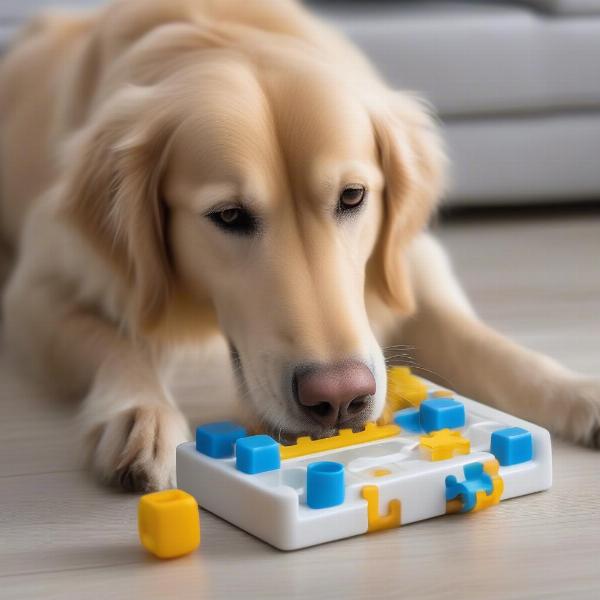Slow feeders have become increasingly popular among dog owners looking to improve their furry friends’ mealtime experience. These specially designed bowls help prevent gulping, promote digestion, and provide mental stimulation. Whether you’re a new dog owner or a seasoned pro, understanding the benefits and choosing the right slow feeder can greatly enhance your dog’s health and well-being.
Why Use a Dog Food Slow Feeder?
Many dogs, especially those who are highly food-motivated or have a competitive eating style, tend to gulp down their food in a matter of seconds. This can lead to a range of problems, including vomiting, choking, and bloat, a potentially life-threatening condition. Slow feeders are designed to combat these issues by forcing dogs to slow down and eat at a healthier pace.
By extending mealtime, slow feeders also offer mental stimulation. Dogs must figure out how to navigate the obstacles within the bowl to access their food, providing a puzzle-like challenge that keeps them engaged and entertained. This can be particularly beneficial for dogs prone to boredom or anxiety. Additionally, slow feeders can aid in digestion by encouraging dogs to chew their food more thoroughly, reducing the risk of digestive upset.
Choosing the Right Slow Feeder
With a wide variety of slow feeders available on the market, selecting the best one for your dog can feel overwhelming. Consider your dog’s breed, size, eating habits, and any specific needs when making your decision.
Types of Slow Feeders
-
Bowls with raised obstacles: These bowls feature various patterns and ridges that create a maze for your dog to navigate. They are generally suitable for most dogs and are available in various sizes and materials.
-
Mats and lick mats: These are flat surfaces with textures and patterns that spread out the food, encouraging licking and slowing down consumption. They are particularly good for dogs who eat very quickly.
-
Puzzle feeders: These interactive toys dispense food as your dog plays with them, providing both mental and physical stimulation. They are a great option for dogs who get bored easily.
Material and Durability
Slow feeders are made from various materials, including plastic, stainless steel, ceramic, and silicone. Consider your dog’s chewing habits when choosing a material. Durable options like stainless steel are ideal for strong chewers.
Size and Capacity
Choose a slow feeder that is appropriately sized for your dog’s breed and food intake. A bowl that is too small may frustrate your dog, while a bowl that is too large may not be effective in slowing down eating.
Tips for Using a Slow Feeder
-
Introduce the slow feeder gradually: Allow your dog to explore the new bowl and get used to the different eating experience. You can start by placing a small amount of food in the slow feeder alongside their regular bowl.
-
Supervise your dog: Especially when first introducing a slow feeder, watch your dog to ensure they are able to access the food and are not becoming frustrated.
-
Clean the slow feeder regularly: Just like regular dog bowls, slow feeders should be cleaned regularly to prevent bacteria buildup.
Troubleshooting Common Issues
-
Dog refuses to eat from the slow feeder: Try adding a small amount of wet food or a tasty treat to the slow feeder to make it more appealing.
-
Dog becomes frustrated: Ensure the slow feeder is not too challenging for your dog. You may need to try a different design or material.
 Dog playing with an interactive puzzle feeder
Dog playing with an interactive puzzle feeder
Conclusion
Dog food slow feeders are a valuable tool for promoting healthy eating habits and providing mental enrichment. By choosing the right slow feeder and introducing it properly, you can significantly improve your dog’s mealtime experience and overall well-being. Remember to consider your dog’s individual needs and preferences when selecting a slow feeder.
FAQs
-
Do all dogs need a slow feeder? While not all dogs absolutely require a slow feeder, they can be beneficial for dogs who gulp their food, experience digestive issues, or need mental stimulation.
-
Can puppies use slow feeders? Yes, slow feeders can be beneficial for puppies as well. Choose a size and design appropriate for their age and size.
-
How often should I clean my dog’s slow feeder? It’s recommended to clean your dog’s slow feeder daily, just like their regular food and water bowls.
-
What if my dog tips over the slow feeder? Some slow feeders have non-slip bases to prevent tipping. You can also try placing the feeder on a mat.
-
Are slow feeders suitable for all types of dog food? Yes, slow feeders can be used with both dry kibble and wet food.
-
Can slow feeders help with weight management? While not a weight-loss solution on their own, slow feeders can contribute to weight management by promoting mindful eating.
-
Where can I buy a dog food slow feeder? Slow feeders are widely available at pet stores, online retailers, and even some veterinary clinics.
ILM Dog is your trusted source for all things dog-related. We offer expert advice on dog breeds, health, training, nutrition, grooming, and much more. From puppy care to senior dog support, we’re here to help you navigate every stage of your dog’s life. Learn more about our services and products by visiting us at ILM Dog or contact us at [email protected] or +44 20-3965-8624.